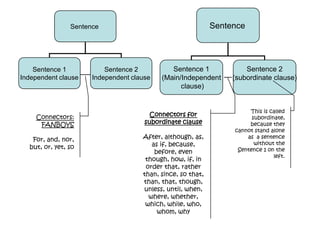Ss diagram joan (1)
- 1. This is called subordinate, because they cannot stand alone as a sentence without the Sentence 1 on the left.Connectors for subordinate clauseAfter, although, as, as if, because, before, even though, how, if, in order that, rather than, since, so that, than, that, though, unless, until, when, where, whether, which, while, who, whom, whyConnectors: FANBOYSFor, and, nor, but, or, yet, so
- 2. If either a subject or a verb is missing, itâs SENTENCE FRAGMENTSIf there is no CONNECTORS (coordinating conjunction), itâs RUN-ON Sentences
- 3. Self-checklist of Sentence StructureYes



